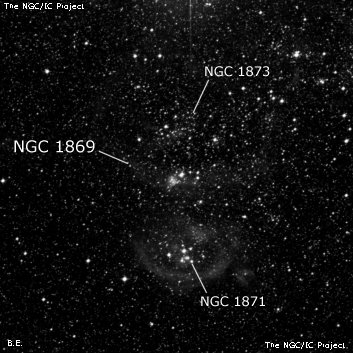
John Herschel discovered NGC 1869 = h2798 on 30 Jan 1835 and described (sweep 658) a "cluster of 7th class; a fine L cluster of scattered stars which fills field. The point taken is the middle of 3 groups [including NGC 1871 and 1873] in the most condensed part." On a second sweep (2 Jan 1837) he noted "The first of a series of clusters which extends northwards as far as B 922 [Theta Doradus]." NGC 2000, ESO and Morel's Visual Atlas of the LMC all identify NGC 1869 with S-L 326, a small cluster flanked by NGC 1871 to the south and NGC 1873 to the north of JH's position. This is the object described by JH on his second sweep. But Jenni Kay notes that "I am confident the small cluster centrally positioned between NGC 1871 and NGC 1873, being 2.5' in size is not JH's cluster. The whole star group is attractive enough to warrant it's own designation. ...the small OC was used to measure a position only for the whole group which is the true NGC 1869 JH cluster." Based on his two sweeps, NGC 1869 refers BOTH to the small cluster and to the star cloud (Lucke-Hodge associations 36/37/38 as well as 34/32).
Wolfgang Steinicke, as well as John Herschel, attributes James Dunlop with the discovery of NGC 1869 on 24 Sep 1826 as his position for D 210 is just 3.4' ESE of S-L 326 in the center of the association (the "point taken" by JH). Dunlop's description reads "a small round nebula, rather faint. This is the preceding in a line of nebulae and small stars, with a star of the 7th magnitude at the north extremity." Although Dunlop gives a sketch, I couldn't match it up with the DSS to tell what object he was sketching. Another reasonable guess is that D 210 applies to NGC 1871, which is the "southern" cluster in a line of nebulae extending north to Theta Doradus.
300/350mm - 13.1" (2/20/04 - Costa Rica): fairly faint, hazy glow (= S-L 326) around a mag 10.5 star (HD 269183) with a couple of mag 12 stars close west. NGC 1873 lies 2.7' N with 1871 4.4' S. Located 11.5' S of mag 4.9 Theta Doradus. Shapley used NGC 1869 as the center of "Constellation" IV, a 33'x33' association of blue supergiants.
600/800mm - 30" (10/12/15 - OzSky): S-L 326 (middle of three clusters within a large star cloud) consists of a mag 11.5 star, along with 5 other fairly bright stars and a number of faint stars (12-15 total resolved). The cluster is encased in an irregular HII glow with a brighter patch (LMC-N30A) to the southeast of the mag 11.5 star. The glow is moderately enhanced with the NPB filter, which reveals nebulosity extending off the cluster to the west. HD 34632 = Brey 17, is a mag 13.1 Wolf-Rayet star (binary) is on the west side of the cluster.
NGC 1873 lies 3' N and NGC 1871 is 4.5' S. All three clusters appear as local enhancements anchored by bright stars and lie within a striking star cloud (large association of blue supergiants including LH 32/34/36/37/38). A rich background glow of unresolved stars extends west and north.
Notes by Steve Gottlieb